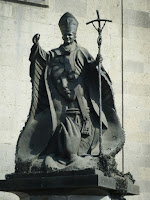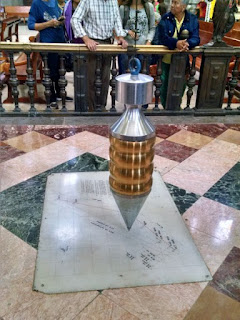We were able to sleep in about a
half-hour later, getting to breakfast about 07:00 then to the bus for an 08:00
departure. We went directly to the Church of Sagrada Familia, just having time along the way for Morning Prayer. This Church
of the Holy Family contains the shrine and relics of Padre Miguel Augustin Pro,
a priest-martyr of the Mexican government’s brutal persecution of the Church in
the 1920s which gave birth to the Cristeros
rebellion (more later) [LINK].
In secret, Padre Pro went around celebrating the Sacraments when they were
forbidden by the government, but was eventually captured and executed on trumped-up charges without
even the benefit of a trial. His execution was filmed pour discouragement les autres (Okay, I know it’s French, but that
paraphrase of Napoleon’s famous statement is what came to mind) and gives us
the iconic shot of him standing cruciform, a crucifix in one hand and a Rosary
in the other, before the firing squad. He was beatified in 1988 – and so is
properly “Blessed Miguel Pro”
although common parlance tends to retain the simpler “Padre Pro” – and I am
certain he will be canonized one day. Incidentally, the effect of the
government’s attempted use of his public, recorded execution was exactly the
opposite of what they desired.
Fr. Juan Diego said Mass in yet
another strikingly beautiful church. We all venerated the relics of Padre Pro,
then stepped out next door into the adjacent museum containing many of his
personal items, relics of his life, priesthood, period in hiding, and eventual
martyrdom.
(At some point in the day we passed and Roberto pointed out the tomb of Padre Pro, but I don't remember exactly when or where it was; we did not stop.)
 Leaving there, we made a short trip
to the Shrine of Our Lady of Covadonga, memorializing one of the few Christian
victories against the Moors in the early 8th century when they swept
across Christian Spain after 711 and reduced the latter to only a small corner
in the northwest, the majority being reduced to Muslim rule for hundreds of
years. As the story goes, one Pelayo rallied the defeated Spanish Christians to
make a stand in 722 at a place of many caves called Covadonga. Pelayo prayed to
the Virgin Mary for victory, and subsequently credited the Christians’ survival
to her intercession and she became a patron of the hundreds-of-years-long war
to drive the Muslims back out of Spain, the Reconquista,
concluded only shortly before the Conquest of Mexico began; many of the conquistadores naturally had a great
devotion to Our Lady of Covadonga.
Leaving there, we made a short trip
to the Shrine of Our Lady of Covadonga, memorializing one of the few Christian
victories against the Moors in the early 8th century when they swept
across Christian Spain after 711 and reduced the latter to only a small corner
in the northwest, the majority being reduced to Muslim rule for hundreds of
years. As the story goes, one Pelayo rallied the defeated Spanish Christians to
make a stand in 722 at a place of many caves called Covadonga. Pelayo prayed to
the Virgin Mary for victory, and subsequently credited the Christians’ survival
to her intercession and she became a patron of the hundreds-of-years-long war
to drive the Muslims back out of Spain, the Reconquista,
concluded only shortly before the Conquest of Mexico began; many of the conquistadores naturally had a great
devotion to Our Lady of Covadonga.Although it was on our itinerary, we saw the National Palace only from the outside, from the other side of the Zocalo, as we walked directly to the Metropolitan Cathedral. I did get a few moments of Roberto describing the Zocalo on video, however.
 As I understand it, the
Zocalo proper, or at least this area, is on the very site of the old Aztec
city of Tenochtitlan; the Metropolitan Cathedral of the Assumption of the Most
Blessed Virgin Mary into Heaven is where the major pyramid-temple to the
blood-thirsty war-god Huitzilopochtli was located [LINK]. Through thick glass plates embedded in the sidewalk before it, you can see what I understood to be some remaining brickwork from that era.
As I understand it, the
Zocalo proper, or at least this area, is on the very site of the old Aztec
city of Tenochtitlan; the Metropolitan Cathedral of the Assumption of the Most
Blessed Virgin Mary into Heaven is where the major pyramid-temple to the
blood-thirsty war-god Huitzilopochtli was located [LINK]. Through thick glass plates embedded in the sidewalk before it, you can see what I understood to be some remaining brickwork from that era. The Metropolitan Cathedral is one of the most magnificent churches I’ve ever seen, a mixture of
architectural styles and design ethics from Renaissance to Baroque to
Neoclassical, reflecting a 200-years-plus period of construction from the 16th
to the 19th centuries. It is absolutely breathtaking. Entry presents you with a smaller church
literally within the larger church, with multiple side-chapels all around; that smaller chapel in the foreground (and pictured at left) is backed by a huge organ; in the distance at the end of the nave can be seen the high altar.
The Metropolitan Cathedral is one of the most magnificent churches I’ve ever seen, a mixture of
architectural styles and design ethics from Renaissance to Baroque to
Neoclassical, reflecting a 200-years-plus period of construction from the 16th
to the 19th centuries. It is absolutely breathtaking. Entry presents you with a smaller church
literally within the larger church, with multiple side-chapels all around; that smaller chapel in the foreground (and pictured at left) is backed by a huge organ; in the distance at the end of the nave can be seen the high altar. Right in the center, there is a massive pendulum with marks on the floor
signifying where the succession of many earthquakes the church has endured has
left the new center of gravity – amazing! We spent a great deal of time
wandering around inside it, seeing before the high altar the tomb of Bishop Zumarraga who received the sign from Our Lady of Guadalupe, and even outside where there is a statue of Pope
St. John Paul the Great made entirely of melted-down keys – that includes an image of Our
Lady of Guadalupe within it.
Right in the center, there is a massive pendulum with marks on the floor
signifying where the succession of many earthquakes the church has endured has
left the new center of gravity – amazing! We spent a great deal of time
wandering around inside it, seeing before the high altar the tomb of Bishop Zumarraga who received the sign from Our Lady of Guadalupe, and even outside where there is a statue of Pope
St. John Paul the Great made entirely of melted-down keys – that includes an image of Our
Lady of Guadalupe within it.
Leaving there (with a bit of an
uproar as one member of the group was missing – she turned up pretty quickly
though; I’m not sure what the issue was), we walked (with a bit of a
“necessary” stop along the way) to the Plaza and Church of Santo Domingo (St.
Dominic) [LINK]
– similarly impressive if on a smaller scale, notable because the very
first Rosary Confraternity in the world was organized there and the Rosary has
been said there every day since the 16th century at 18:00 in the Shrine of Our Lady of the Rosary. We walked
back to the Cathedral where we had to wait quite a while for the bus to meet
us. Traffic was pretty bad.
On the way back to the hotel, along with Evening Prayer and the Rosary,
Roberto pointed out the Angel Monument to Mexican Independence a few blocks
from where we passed, where we could see a number of young women in colourful
dresses. It is a common place to come take pictures for young ladies’ quinceaneras [LINK]. Having a while
between when we arrived at the hotel and supper at 19:00, Anne and I went
walking. We tried to get to the Angel Monument, but it’s surrounded by the big
roundabout with multiple lanes of traffic flowing around it – and no
immediately apparent place to cross – so we ended up walking back around some
other streets in the area, popping in a few stores such as a liquor store where
we bought a couple of gifts, a pharmacy where we bought a couple of toiletry
items we needed, and so forth. Incidentally, at some point on the pilgrimage
the subject of “our” street’s name came up – Calle Hamburgo. This area is an old diplomatic district, and there
are a number of such names commemorating various places in Europe.
After supper – I don’t remember who
we sat with – and taking a while to transfer the day’s pictures to the laptop
and external hard drive, Anne and I went all the way up to the top of the
hotel, the “Penthouse” level, where there is an open-air pool, exercise rooms,
conference rooms, allegedly a bar, and so forth. It was deserted although we
had heard of members of our group congregating there in the evening for drinks;
it was quite cool this evening. There was quite an impressive view out across
the city, but we very soon went back down to the bar, where we found no one
from our group either. We enjoyed drinks on our own – a margarita for me
(unfortunately not blue), a mojito for Anne. I did realize halfway through
that, although we’d been avoiding water even in the hotel, there was ice in
both our drinks. We believe it was from filtered water anyway, and didn’t
suffer any ill-effects. Really, it probably wasn’t the first time we’d had it –
I don’t remember the blue margarita from Thursday night not having ice, come to think of it. In any case, we then returned
to our room to get prepared for a very early morning on Sunday, to begin a very
long day that we were warned would not have us back to the hotel before 20:00.[1]
+ + +
More Pictures from the Day
[1] Given that Sunday 07 February would be the date of Superbowl 50, I
expected to hear howls of protest. I did not.























































































































































No comments:
Post a Comment